Leaders in Geoscience: “Women who rock on the JR”
Leaders in Geoscience: “Women who rock on the JR”
It has been an honor working on the JR, with so many people who have a passion for geoscience and oceanography. In particular, the remarkable group of young women scientists on board Expedition 371. They are without doubt, exceptional role models for young females looking into a scientific career. A career in Geoscience, was traditionally dominated by males, but this field has exploded to include females in every aspect.I asked all the women scientists currently on board the JR, to write a paragraph about themselves, and their role on EXP371. I was overwhelmed by the response, and the unbelievable talent I was surrounded by. They have not only achieved great heights, but set new standards; and still exhibit modesty and are very down to earth.
Laia Alegret
Laia is a Senior Lecturer in Paleontology at Zaragoza University in Spain.
After completing her PhD thesis on micropaleontology and sedimentology across the Cretaceous/Paleogene (or Cretaceous/Tertiary) mass extinction event (cum laude and Best PhD Dissertation Award) in 2002, she worked at University College London as a Postdoctoral Fellow until 2005. In addition to short stays at other institutions (Yale University, MIT, Wesleyan University, Smithsonian Institution, University of Boulder CO, Plymouth University, etc.), she has created a wide network on international collaborators. She is vice chair of the International Subcommission on Paleogene Stratigraphy ([http://www.paleogene.org)/]http://www.paleogene.org), editor of Journal of Micropaleontology, among other journals, Associate of the Spanish National Evaluation Agency, and a frequent collaborator of the European Commission and other international funding agencies.
Her research is focused on the application of benthic foraminifera (microfossils) in understanding ocean and climate changes using marine sediments from land-sections and deep-sea cores. The study of fossil shells of benthic foraminifera provides paleontologists with a valuable record of the paleoenvironmental changes that occurred at the seafloor millions of years ago. She is particularly keen on the analysis of critical events along Earth´s history, such as the impact of a meteorite at the Cretaceous/Paleogene boundary, which led to the extinction of many species (including dinosaurs), the effects of the late Paleocene greenhouse world and global warming events on the biota, or climate change and cooling events associated to the early Oligocene glaciation.
She has authored 130 scientific publications, including 6 books and articles in highly cited journals such as Science, PNAS, Geology, Palaeoceanography or GSA Bulletin.
Onboard the JR she is providing paleoenvironmental control of the recovered sediments using benthic foraminifera. The combination of quantitative studies of their assemblages and stable isotope analyses of their tests will contribute to infer paleobathymetry and changes in the chemistry of the oceans, to characterize ocean water masses, to test the sensitivity of the assemblages during times of elevated pCO2, to infer changes in the global carbon cycle, and to feed paleoclimate models.
Claudia Agnini
Claudia is an Italian micropaleontologist, she is sailing on the JR as calcareous nannofossil specialist. She is Associate Professor at Padova University (Italy) where she teaches micropaleontology and paleoclimatology. Her main task on board is to date cores coming up from the sea floor as soon as possible because sometimes decisions on drilling operations are made based on scientific objectives than have well constrained ages.
Claudia wrote it about the 45st day of Exp. 371
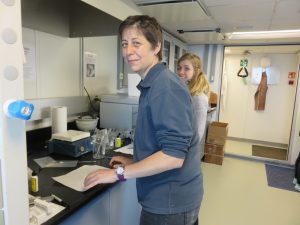 We just arrived at Site 1510 after some days trying to avoid a storm coming from the South. The work that all the scientists are doing here is really hard, 12 hours per day 7 days per week, and it would be reasonable just want to have a break like the one we had. But this is not the case, everyone here is so excited about this new site. It is quite shallow and this means that the cores will come up so quickly that we will probably not be able to cope it. But, you know, scientists like challenges and this expedition is exactly what I want to experience, we are exploring the hidden part of the 8th continent and what we have drilled up to now is so new and unexpected. I’ve already sailed on the JR in 2012 but I have to say that I didn’t fully realize the complexity of this program…. Nothing can be done without the hard work of the crew, the know-out of all the technicians and the scientist expertise and …..a lot of fun!!!
We just arrived at Site 1510 after some days trying to avoid a storm coming from the South. The work that all the scientists are doing here is really hard, 12 hours per day 7 days per week, and it would be reasonable just want to have a break like the one we had. But this is not the case, everyone here is so excited about this new site. It is quite shallow and this means that the cores will come up so quickly that we will probably not be able to cope it. But, you know, scientists like challenges and this expedition is exactly what I want to experience, we are exploring the hidden part of the 8th continent and what we have drilled up to now is so new and unexpected. I’ve already sailed on the JR in 2012 but I have to say that I didn’t fully realize the complexity of this program…. Nothing can be done without the hard work of the crew, the know-out of all the technicians and the scientist expertise and …..a lot of fun!!!
Kristina Pascher
Kristina is a German micropaleontologists currently based at GNS Science, Lower Hutt, New Zealand. She completed a PhD on the distribution of Eocene radiolarians in the southwest Pacific earlier this year at Victoria University of Wellington in collaboration with GNS Science. Onboard the JR she is providing biostratigraphic age control of the recovered sediments using radiolarians.
Kristina wrote about the 42nd day on Exp371:
Today we have finished drilling at the 4th site. But we are expecting some bad weather and so we’ll cruise north to escape th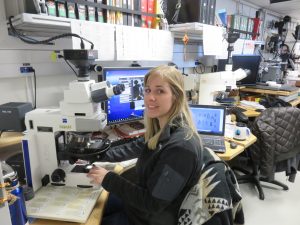 e storm that’s coming from the southwest. Apparently, we will still be getting a ~10m swell! The WOW (waiting out the weather) will take us 2 days or so and if nothing more comes our way, we will arrive at out next site on Monday. The site we’ve just finished had some great surprises for me, super well-preserved Eocene rads! So far, the Eocene rads were either not there, or super sparse and crappy preserved at the other 3 sites we drilled so far. But this site here has amazing and lots of rads through most of the cored interval, we are speaking of ~400m, from the the top, through the Pliocene, Miocene, Oligocene until the middle Eocene.
e storm that’s coming from the southwest. Apparently, we will still be getting a ~10m swell! The WOW (waiting out the weather) will take us 2 days or so and if nothing more comes our way, we will arrive at out next site on Monday. The site we’ve just finished had some great surprises for me, super well-preserved Eocene rads! So far, the Eocene rads were either not there, or super sparse and crappy preserved at the other 3 sites we drilled so far. But this site here has amazing and lots of rads through most of the cored interval, we are speaking of ~400m, from the the top, through the Pliocene, Miocene, Oligocene until the middle Eocene.
So, hopefully the ship is not rolling too much the next few days, so I can still do some microscoping…telling you, it’s not fun trying to keep stable on a chair and trying not to knock your head against the eyepieces every time a big wave hits..
Michelle Drake
Michelle is a sedimentologist and paleoceanographer from the United States. She is a PhD candidate at the University of California, Santa Cruz. Her research focuses on reconstructing the changing oceanography of the Pacific Ocean over the last 10 million years. Onboard the JR she is part of the eight-person core description team, which names and describes every sediment core recovered during Expedition 371.
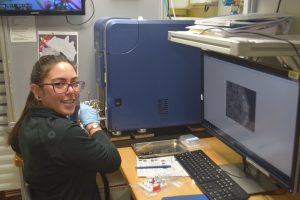 Michelle’s favorite part of sedimentology:
Michelle’s favorite part of sedimentology:
On Expedition 371 we have been describing meters of white sediments (image on left). A sediment core can appear very simple, just a nine and a half meter long tube of mud (fine grained material that is smaller than sand). But, when you look at the sediment under the microscope you learn the material is much more complex. This white sediment is made up of millions of fossilized organisms called foraminifera (image on the right). A foraminifera is a single celled animal that produces a calcium carbonate shell and lives in at the oceans surface. Identifying and measuring the microscopic components of the sediment is a critical part of my work on the JOIDES resolution. Two sediment cores may seem similar, but when you observe their microscopic composition it becomes clear they are made up of many different microfossils and minerals.
Adriane Lam
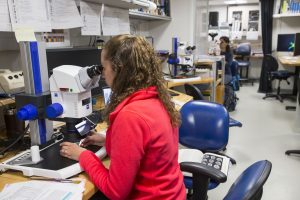
Adriane is an American micropaleontologist who is currently pursuing her PhD at the University of Massachusetts, Amherst in Massachusetts. Her current research involves characterizing the development of western boundary currents through the last 15 million years in the Pacific Ocean. She is also studying how evolution occurs within marine plankton lineages associated with these currents. Adriane has background training in invertebrate paleontology, and has a profound love of her friends and family, fossils, cats, and chocolate lava cakes. She is sailing aboard the JR as a planktic foraminiferal biostratigrapher, but also provides identifications of invertebrate fossils when they are found.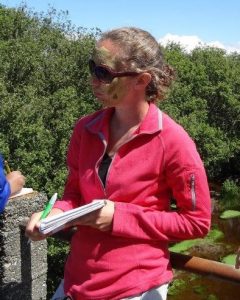
Adriane is very active in education outreach, both in her community and online. She regularly volunteers with her local fossil club to teach people the importance of the fossil record and about how climate change will affect life on Earth. In her free time, Adriane, along with her colleague, Jen, runs a website and blog dedicated to informing the public about climate change and evolution (www.timescavengers.blog).
Allison L. Keller

Attending the University of California at Riverside, Allison is a third year PhD student working in the field of paleoclimatology and paleoceanography. A majority of her work has focused on long- and short- term warming events through the Late Paleocene and early-middle Eocene from sediment in the Northwestern Atlantic Ocean, IODP Site U1409. Recently she has been utilizing benthic foraminifera found in the cores to obtain stable isotopic signatures for indications of paleoclimate (as recognized from oxygen isotopes; δ18O) and the carbon perturbation history (as recognized from carbon isotopes; δ13C) to compare with her bulk (averaged water column) sediment records. Her plans onboard the JR, however, are to pick fossil fish teeth for a continuous record on ocean circulation changes across tectonic timescales. This involves microscope work, so hopefully the weather gets better soon so some preliminary work can get done!
He Li
He Li is a Chinese Inorganic geochemist currently based at Institute of Oceanology, Chinese Academy of Sciences. She completed a PhD five years ago at Guangz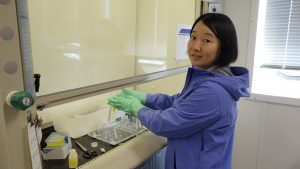 hou institute of Geochemistry, Chinese Academy of Sciences. She worked on the arc magma initiation and evolution respond to the subduction initiation by geochemical method. Onboard the JR, she is providing chemistry nature of the pore water in sediments and will provide geochemical characteristics of the volcanic rocks and minerals in cores from this expedition.
hou institute of Geochemistry, Chinese Academy of Sciences. She worked on the arc magma initiation and evolution respond to the subduction initiation by geochemical method. Onboard the JR, she is providing chemistry nature of the pore water in sediments and will provide geochemical characteristics of the volcanic rocks and minerals in cores from this expedition.
Joyeeta Bhattacharya
Joyeeta is a Graduate Research Assistant in the Department of Earth, Environmental and Planetary Sciences, Rice University, Houston, USA. She completed her Bachelor of Science and Master of Science degrees in Geology from Jadavpur University, India before she moved to the United States in 2015 for PhD.
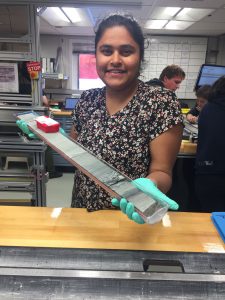 Joyeeta is a Shipboard Sedimentologist aboard the JR, on Expedition 371. Currently her research focusses on how deep marine carbonate rich sediments undergo carbonate dissolution in response to warm climatic events ~56-34 million years ago, when our planet experienced a significant transition from greenhouse to icehouse climatic conditions. In this ongoing IODP expedition, she aims to work on the same age sediments and rocks that are being drilled in the present site and will be drilled in the upcoming sites.
Joyeeta is a Shipboard Sedimentologist aboard the JR, on Expedition 371. Currently her research focusses on how deep marine carbonate rich sediments undergo carbonate dissolution in response to warm climatic events ~56-34 million years ago, when our planet experienced a significant transition from greenhouse to icehouse climatic conditions. In this ongoing IODP expedition, she aims to work on the same age sediments and rocks that are being drilled in the present site and will be drilled in the upcoming sites.
While on the JR, she works in a team of 8 scientists, separated into two halves (midnight – noon shift and noon- midnight shift) who focus on shipboard sedimentology, in simpler terms “Core Description”. The work encompasses one of the most crucial aspects which is nomenclature of a rock/sediment. Just to put a suitable name to the sediment/rock, Joyeeta and her Sedimentology team members must do a number of jobs during her shift which ranges from taking high resolution images, to measuring magnetic susceptibility, to preparing smear slides and thin section for observation of microscopic constituents of the sediment/rock and most importantly do a very keen macroscopic examination of the cores. Summing all the observations a name is assigned to the sediment/rock which in turn helps to depict the changes occurring downhole and that becomes the backbone of any further investigation and interpretation/scientific study to be done on these sediments/rocks.
Joyeeta simply enjoys getting a steady flow of cores in the lab because while on sea time tends to run slow if one does not have enough work to do. She is sailing as a scientist for the first time and is in a very early career stage, therefore this expedition has been immensely useful in terms of her learning curve as well as networking. Last but not the least, IODP expedition 371 seems to have made her very confident and able in terms of dealing with scientific questions and understanding the complicated geological history of the planet Earth!
Xiaoli Zhou
Xiaoli is a Chinese inorganic geochemist currently based at Rutgers University, New Jersey, United States. She finished her PhD last summer on the redox changes in the upper ocean and bottom water in the paleo-oceans during the Paleocene Eocene Thermal Maximum and in the Oceanic Anoxic Event 2. Onboard the JR she is collecting interstitial waters from sediments and generating pore water chemistry profiles by multiple instruments.
General thoughts:
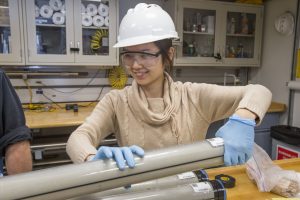
It has been exciting to work as an inorganic geochemist on the JR. This expedition is special that Zealandia has not been thoroughly explored before, so anything find during this voyage would be novel and has profound impact in the future investigations. We have finished drilling four sites so far, and cored quite a long record of sediments. They provide critical evidence for understanding tectonic and paleoclimate histories in this region.
I have learned a lot during this expedition. Pore water chemistry is a completely new research field for me, which compliments my past experiences on trace element studies in solid sediments. It also inspired me to think about scientific questions I never thought of before. Furthermore, I picked up lots of knowledge in other earth science subfields from my ship colleagues, which helps me understand the panoramic picture of the scientific objectives of this expedition.
The scientist party in this expedition consists of a big group of early career young people. I believe this voyage will change the direction of some scientists’ career paths, in a good way. I really enjoyed this expedition, and hope everyone will get off the ship with a good scientific story!
Cherry Newsam
Cherry is sailing for the first time onboard the Joides Resolution as one of the nannopaleontologists, providing biostratigraphic age control as part of the Paleo team. Having recently graduated from a PhD in ‘Nannoplankton evolution and the Paleogene greenhouse to icehouse climate-mode transition’ at University College London, UK, working with sediments recovered on IODP Expedition 342, she was keen to get first hand ocean drilling experience.
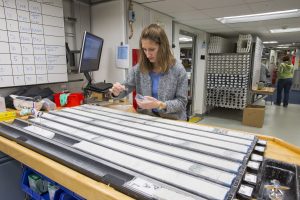
Cherry has particular interest in calcareous nannofossil biostratigraphy, taxonomy and using nannofossil palaeoecology to infer palaeoenvironmental conditions and has been able to apply all of these disciplines to her work onboard. Although her previous work has focused on the Paleogene, she has enjoyed branching out into new intervals of time whilst onboard the Joides Resolution. In the role of a nannopaleontologist Cherry has to provide quick age control on the core that has just been received on the core deck. Cherry makes a nannofossil smear slide using a toothpick of sediment from every core catcher sample and then analyzes this slide straight away under the microscope to look for key nannofossil marker species in order to determine the age of the sediment.
Cherry has really enjoyed working together as part of a team in the Paleo lab with nine other paleontologists, all from different countries, providing their expertise on different microfossil groups. She finds it a rewarding experience to combine the biostratigraphic results with data collected by other teams onboard sedimentologists, paleomagnetists, physical properties, geochemists, in order to understand the tectonic and paleoceanographic history of the region.
May Huang
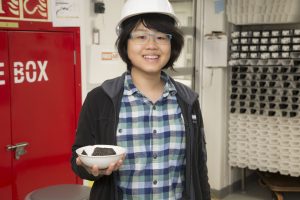
May is a Taiwanese micropaleontologist currently studying PhD in the University of Hong Kong, and working as a research intern in the University of Tokyo. On board the JR she provides paleodepth estimates of the recovered sediments using ostracods.
We have finished drilling at Site U1510, and are now on our way through bad weather to Site U1511. The waves have been quite rough so far during this expedition. I love watching waves, but it’s too dangerous to stay outdoor today.
I’m studying ostracods in the paleontology lab during the transit. The shipboard lab is a truly unique working environment for micropaleontologists as we are handling microscopic-size specimens while the ship is breaking through 10-m high waves. Ostracods are tiny bivalved crustaceans with a wide variety of ecological preferences, and are useful for paleoenvironmental studies. For this expedition, I specifically focus on shallow and deep water species for paleodepth estimates. Finding ostracods in deep-sea samples is usually challenging, but the good news is that I have discovered hundreds of ostracods with high diversity in Site U1510.
Yu-Hyeon Park
Yu-Hyeon is a geochemist from Korea. She is exploring Zealandia with a wonderful group of scientists from many different countries throughout IODP . Her main goal on this expedition is to reveal the tectonic changes around the Tasman Sea and to find evidence associated with the tectonic events and any related Cenozoic climate changes. Her research target, throughout this expedition, is to reconstruct paleo-temperatures using biomarkers of membrane lipid in the sediment for recent to Paleocene times.
Her primary role on board, is as an organic geochemist. As an organic geochemist, her job is to measure gas concentration such as methane from the sediment, for safety monitoring at the drilling sites. She analyzes the contents of fundamental elements such as carbon, nitrogen and carbonate from the sediments. These experiments involved are very simple and a routine process. For example, she grinds the sediment and weighs the samples. However, it is essential to get reliable results as the data must quickly show the sediment character, and monitor any environmental changes.
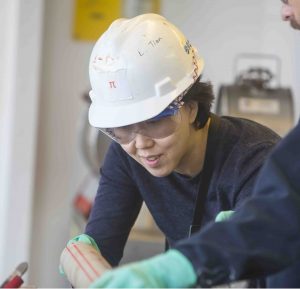
Light color of sediment indicates a high content of carbonate and dark color of sediment indicates low content of carbonate.Guess? What is the amount in black color in the sediment? The answer is that each black of the black layers has a very different value. What happened??? This is a homework for all of us.
As Yu-Hyeon says today is the 54th day on Exp371, and there are only 8 days left before we get land. We are all tired of big waves, working for 12hours a day, experiments, discussion and many reports to write. Although we are all very tired, people’s faces always show a sign of passion. It’s time…..Core on deck!! Cheer up everyone, we are almost there!!!
Wanda Stratford
Wanda Stratford is a Marine Geoscientist working at GNS Science in Wellington, New Zealand. She studied Geology, physics and geophysics in New Zealand, completing a PhD in geophysics at Victoria University of Wellington, New Zealand. This was followed by post-doctoral research with ETH Zurich, Copenhagen University and Durham University in the United Kingdom. Her research has included the study of Subduction zones, back arcs, mountain ranges, sedimentary basins and submarine plateaux.
Onboard the Joides Resolution, Wanda works as a physical property expert. Her role is to analyse the recovered cores using several different measurement techniques to determine the nature of the sediment. Measurements include that of velocity, density, porosity, magnetic susceptibility and natural gamma radiation. She also tries to compare the recovered core material to exploration seismic data that maps out regional patterns of sediment change.
The cruise is the culmination of about 2 years of preparation work gone into finding the right sites to drill and doing all the background research required to make it as successful as possible. Being onboard has been exciting, watching the real time science happen, watching our predictions come true, or surprises happen. And working with such a wide range of scientists with various expertise. These voyages are a true synthesis of scientific techniques, and the results are more robust because of it.
Pictured below: Claudia Agnini , Laia Alegret, Joyeeta Bhattacharya, Margot Cramwinckel, Michelle Drake, May Huang, Alison Keller , Adriane Lam, Li He, Cherry Newsam, Yu-Hyeon Park, Kristina Pascher, Wanda Stratford, Xiaoli Zhou, Debra Beamish Absent: Gayane, Asatryan
